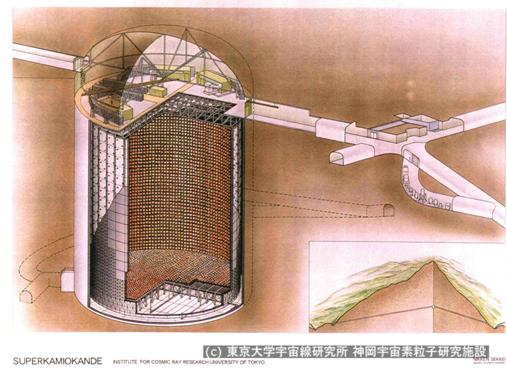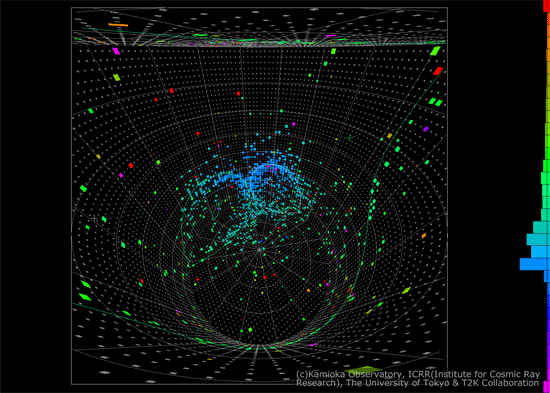| |
Tsukuba, February 24, 2010. Physicists from the Japanese-led multinational T2K collaboration announced today that they had made the first detection of a neutrino which had travelled all the way under Japan from their neutrino beamline at the J-PARC facility in Tokai village (about an hour north of Tokyo by train) to the gigantic Super- Kamiokande underground detector near the west coast of Japan, 295 km (185 miles) away from Tokai.
"It is a big step forward," said T2K spokesperson Takashi Kobayashi. "We've been working hard for more than 10 years to make this happen."
They have constructed their new neutrino beamline, which will deliver the world's most powerful neutrino beams, to study the mysterious phenomenon known as neutrino oscillations, and the observation of this event proves that their study can now begin.
"Neutrinos are the elusive ghosts of particle physics," Kobayashi explains. "They come in three types, called electron neutrinos, muon neutrinos, and tau neutrinos, which used to be thought to be immutable."
Interacting only weakly with matter, neutrinos can traverse the entire earth with vastly less attenuation than light passing through a window. The very weakness of their interactions allows physicists to make what should be very accurate predictions of their behavior, and thus it came as a shock when measurements of the flux of neutrinos coming from the thermonuclear reactions which power our sun were far lower than predicted. A second anomaly was then clearly demonstrated by Super-Kamiokande, when it showed that the flux of different types of neutrino generated within our atmosphere by cosmic ray interactions was different depending on whether the neutrinos were coming from above or below (which should not have been possible given our understanding of particle physics). Other experiments, such as KamLAND (also performed at Kamioka), have conclusively demonstrated that these anomalies are caused by neutrino oscillations, whereby one type of neutrino turns into another.
"Congratulations from CERN on the first T2K neutrino event seen at Super-Kamiokande," said CERN Director General Rolf Heuer. "Switching on one of the world's first neutrino superbeams is a great achievement, and is set to bring great advances in the understanding of this most elusive of particles. Even in a time of financial difficulty around the globe, it's important not to lose sight of the fact that basic science is and always will be a crucial element of progress. It is therefore heartening to see such an important new basic science initiative getting underway now."
The T2K experiment has been built to make measurements of unprecedented precision of known neutrino oscillations, and to look for a so-far unobserved type of oscillation which would cause a small fraction of the muon neutrinos produced at J-PARC to become electron neutrinos by the time they reach Super-Kamiokande.
"This first neutrino event marks a great achievement for T2K and a milestone for the fast-growing field of neutrino physics worldwide," said Fermilab Director Pier Oddone. "We send warmest congratulations from Fermilab, along with our best wishes for the exciting science that will follow."
Excitement is shared by Dr. Nigel Smith, SNOLAB Director: "SNOLAB warmly congratulates the T2K team on this tremendous milestone for their project, which highlights the great achievements made by this collaboration in the development of new detectors and accelerator technology. The knowledge that T2K will tease out about the elusive neutrino will further our understanding of these sub-atomic particles and their role within the Universe, and why the Universe looks the way it is." Prof. Dr. Joachim Mnich, Director in charge of High Energy Physics and Astroparticle Physics at DESY also notes: "Warmest congratulations from DESY on seeing the first neutrino event and thus becoming leader in the race to understand the elusive neutrino! Through our long history of collaboration with Japanese scientists and labs we value your work most highly and hope that the T2K project will help make the neutrino less elusive."
Observing the new type of oscillation would open the prospect of comparing the oscillations of neutrinos and anti-neutrinos, which many theorists believe may be related to one of the great mysteries in fundamental physics -- why is there more matter than anti-matter in the universe? "The observation of this first neutrino (see figure) means that the hunt has just begun," said Prof. Koichiro Nishikawa, Director of the Institute for Particle and Nuclear Studies at KEK and founder of T2K. "The first physics results are expected later this year. This is the beginning. I am waiting for a lot more to come soon!"
Background: The T2K collaboration consists of 508 physicists from 62 institutes in 12 countries (Japan, South Korea, Canada, the United States, the United Kingdom, France, Spain, Italy, Switzerland, Germany, Poland, and Russia). The experiment consists of a new neutrino beamline using the recently constructed 30 GeV synchrotron at the J-PARC laboratory in Tokai, Japan, a set of near detectors constructed 280m from the neutrino production target, and the Super-Kamiokande detector in western Japan.
The complete list of institutions can be found at:
http://neutrino.kek.jp/t2k/T2KInstitutions.pdf
The T2K experiment would like to thank the following funding agencies for their generous support:
Ministry of Education, Culture, Sports, Science, and Technology (MEXT), Japan
The Department of Energy, the United States
The Natural Science and Engineering Research Council, Canada
The National Research Council, Canada
The Science and Technology Facilities Council, the United Kingdom
Institut National de Physique Nucléaire et de Physique de Particules (IN2P3/CNRS), France
Commissariat à l'Énergie Atomique (CEA), France
The Swiss National Science Foundation, Switzerland
State Secretariat for Education and Research SER, Switzerland
ETH Zurich, Switzerland
Istituto Nazionale di Fisica Nucleare (INFN), Italy
Ministerio de Ciencia e Innovacion, Spain
Ministry of Science and Higher Education, Poland
Ministry of Education and Science, Russia
Russian Academy of Sciences
Deutsche Forschungsgemeinschaft, Germany
Ministry of Education, Science & Technology (MEST), South Korea
The European Research Council
| [ Media Contact ] |
Youhei Morita,
Head of Public Relations Office, KEK
tel. +81-29-879-6047 |
 |
| Figure 1 : A schematic of a neutrino's journey from the neutrino beamline at J-PARC, through the near detectors (yellow dot) which are used to determine the properties of the neutrino beam, and then 295 km underneath Japan to Super-Kamiokande. |
 |
| Figure 2 : A cutaway drawing of the Super-Kamiokande Detector. The detector is a 40m diameter by 40m high cylinder filled with ultrapure water and surrounded by more than 10,000 50cm phototubes (PMTs), each sensitive enough to see a single photon. |
 |
| Figure 3 : The first T2K event seen in Super-Kamiokande. Each dot is a PMT which has detected light. The two circles of hits indicate that a neutrino has probably produced a particle called a π 0, perfectly in time with the arrival of a pulse of neutrinos from J-PARC. Another faint circle surrounds the viewpoint of this image, showing a third particle was created by the neutrino. |
|

